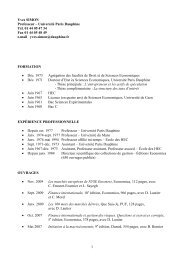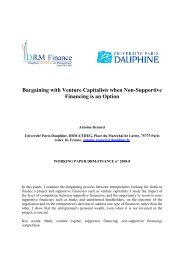Corporate governance and earnings management ... - CEREG
Corporate governance and earnings management ... - CEREG
Corporate governance and earnings management ... - CEREG
Create successful ePaper yourself
Turn your PDF publications into a flip-book with our unique Google optimized e-Paper software.
The second view, rather larger, concerned proponents of the dynamic approach (phase 3).<br />
For them, the cost of goodwill should be spread systematically over a certain number of<br />
periods reflecting the way it was used or calculated. This group includes Guthrie (1898, p.<br />
429) who recommended the following basis for amortization: “the amount of the years’<br />
purchase of the goodwill as originally paid so far as the excess profits”.<br />
Finally, the third position, <strong>and</strong> at the time the only credible alternative to the purely static<br />
approach, rallied authors who (also) proposed making goodwill disappear from the accounts<br />
immediately, but by charging it to equity (variation of phase 2). This was the position of<br />
writers such as Dicksee (1897), whose later influence was to be fundamental (see below).<br />
To conclude for this phase, many who opposed the principle of the static view finally<br />
changed their minds in practice once under its pressure. Browne (1902, p. 1342), for example,<br />
after declaring his hostility to profit reduction, adds, “I do not go so far to say that it may not<br />
be desirable in many cases to strengthen a concern by reducing… the book value of its<br />
goodwill, but the application of profits in this direction would be more in the nature of a<br />
voluntary appropriation than a necessary charge”. Pain (in Browne, 1902, p. 1344), who was<br />
not very favorable to writing off goodwill against profits, finally said, “at the same time, the<br />
old adage about providing for a rainy day furnishes a stronger argument in favor of arming<br />
oneself against a contingency which is not impossible of realization in any concern” (our<br />
emphasis).<br />
Globally speaking this prudent accounting conception is not a surprise: it is in line with the<br />
social <strong>and</strong> economic context of the period (Parker, 1965, p. 160). As it has clearly been shown<br />
by historians at that time, in line with a situation coming from the 18 th century, it is no doubt<br />
that the “horror of failure” (Hoppit, 1987, p. 16) still caught eye an imagination. For that<br />
reason most business man prefer to rely on their own resources or provided by people they<br />
know well (Wilson, 1995, p. 46). In that context personal credit could play a central role but<br />
was associated with the moral obligation to reimburse <strong>and</strong> a severe penalty for ignoring<br />
19



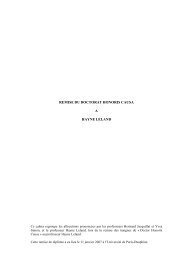

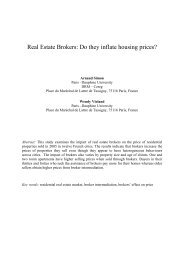
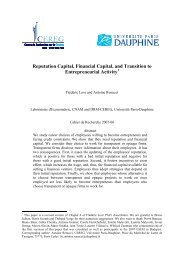

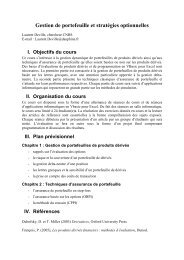



![& 6 ] ^ F ]^ - CEREG - Université Paris-Dauphine](https://img.yumpu.com/33326502/1/184x260/-6-f-cereg-universitac-paris-dauphine.jpg?quality=85)

